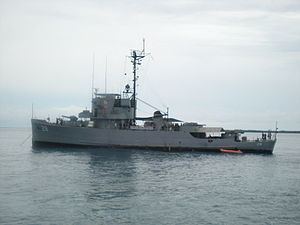Name PCE-881 Commissioned 31 July 1944 Namesake Cebu Launched 10 November 1943 Builder Portland | Laid down 21 August 1943 Name Cebu Construction started 21 August 1943 Displacement 829,200 kg | |
 | ||
Fate transferred to the Philippine Navy, July 1948 | ||
BRP Cebu (PS-28) is a Miguel Malvar-class corvette of the Philippine Navy. She was originally built as USS PCE-881, a PCE-842-class patrol craft for the United States Navy during World War II and patrolled the Alaskan coast during that war. She was decommissioned from the U.S. Navy and transferred to the Philippine Navy in July 1948 and renamed RPS Cebu (E-28) after the Philippine province of the same name. The ship is in active service. Along with other World War II-era ships of the Philippine Navy, Cebu is considered as one of the oldest active fighting ships in the world today.
Contents
History
Commissioned in the US Navy as USS PCE-881 in 1944, and patrolled the coast of Alaska during World War II. The ship was decommissioned after World War II.
She was then transferred and commissioned into the Philippine Naval Patrol and was renamed RPS Cebu (E-28) in July 1948. She was carried on to the Philippine Navy in 1950, and between 1965-1966 she was renamed as RPS Cebu (PS-28) using a new classification system. Again in June 1980 she was renamed BRP Cebu (PS-28) using a new localized prefix.
In 1992 the Iloilo underwent major overhaul, weapons and radar systems refit, and upgrade of communications gear.
Cebu won the Philippine Navy "Ship of the Year" award for the year 2009.
She is currently assigned with the Patrol Force of the Philippine Fleet, under the jurisdiction of Naval Forces Western Mindanao.
Notable Operations
After the ship's construction and the crew's training was completed in Portland Oregon, it patrolled the coast of Alaska from the Aleutian Islands to the Bering Strait during World War II. The ship’s commanding officer was Lieutenant Commander W.W. Adams.
Between 19 and 22 March 1958, then RPS Cebu participated in the first bilateral exercise between the Philippine and US Navies dubbed Exercise "Bulwark One". It took part on the 3rd phase of the exercise off the waters of Corregidor and Caballo Islands.
As of 23 June 2008, she and her onboard medical team participated in the search and rescue of the MV Princess of the Stars of Sulpicio Lines, which capsized off the coast of San Fernando, Romblon at the height of Typhoon Fengshen on 22 June 2008.
BRP Cebu and BRP Pangasinan (PS-31) have alternately secured the Southern Sulu Sea where the Baduria Well is located. She also provides security for the West Aquarius Oil Rig.
Technical details
There are slight difference between the BRP Pangasinan as compared to some of her sister ships in the Philippine Navy, since her previous configuration was as a patrol craft escort (PCE), while the others are configured as rescue patrol craft escort (PCER) and minesweepers (Admirable class) ships.
Armaments
Originally the ship was armed with one Mk.26 3"/50 caliber dual purpose gun, three twin Mk.1 Bofors 40 mm guns, four Mk.10 20 mm Oerlikon guns, 1 Hedgehog depth charge projector, four depth charge projectiles (K-guns) and two depth charge tracks. This configuration applies before its overhaul in the early 1990s.
During its overhaul and refit in 1992, the Philippine Navy removed her old anti-submarine weapons and systems, and made some changes in the armament set-up. Some sources claim the loss of its three Bofors 40mm cannons during the 1990-1991 overhaul and refit period, but photos [1] at of 2009 show the Bofors guns still present, although in singles instead of twins. Final armaments fitted to the ship are one Mk.26 3"/50-caliber gun (fore), three single Bofors 40 mm cannons (aft), four Mk.10 Oerlikon 20 mm cannons (2 each on bridge wings), and four M2 Browning 12.7 mm/50 caliber machine guns (2 besides main bridge, 2 aft near the ship's end). This made the ship lighter and ideal for surface patrols, but losing her limited anti-submarine warfare capability.
Electronics
Also during the refit the ship's SPS-21D surface search radar and RCA SPN-18 navigation radar was replaced by a Raytheon AN/SPS-64(V)11 surface search and navigation radar system. Later modifications included the installation of long range and satellite communications systems, and GPS system standard to all Philippine Navy ships.
Machinery
The ship is powered by two GM 12-278A diesel engines, with a combined rating of around 2,200 bhp (1,600 kW) driving two propellers. The main engines can propel the 914 tons (full load) ship to a maximum speed of around 16 knots (30 km/h).
